Not to be confused with
Khnum.
Among the Nenets people of Siberia, the male Num was the sky god, the good creator of earth and the high god of the Nenets. Num is one of two demiurges, or supreme gods. The Nenets believed earth and all living things were created by the god Num and every heavenly sphere is ruled by one son of the Num god. Nga was his malevolent son.
According to one story, the world threatened to collapse on itself. To try to halt this cataclysm a shaman sought the advice of Num. The shaman was advised to travel below the earth, to Nga's domain and call upon him. The shaman did as told and was wed with Nga's daughter. After that point he began to support the world in his hand and became known as "The Old Man of the Earth."
In another myth, Num and Nga create the world, collaborating and also competing with each other — the myth is an example of dualistic cosmology. [1]
The word Num means heaven in Nenets.

Shamanism is a religious practice that involves a practitioner, a shaman, who is believed to interact with a spirit world through altered states of consciousness, such as trance. The goal of this is usually to direct these spirits or spiritual energies into the physical world, for healing or some other purpose.

The Khanty are a Ugrian indigenous people calling themselves Khanti, Khande, Kantek (Khanty), living in Khanty–Mansi Autonomous Okrug, a region historically known as "Yugra" in Russia, together with the Mansi. In the autonomous okrug, the Khanty and Mansi languages are given co-official status with Russian. In the 2010 Census, 30,943 persons identified themselves as Khanty. Of those, 26,694 were resident in Tyumen Oblast, of whom 17,128 were living in Khanty–Mansi Autonomous Okrug and 8,760—in Yamalo-Nenets Autonomous Okrug. 873 were residents of neighbouring Tomsk Oblast, and 88 lived in the Komi Republic.

The Nenets, also known as Samoyed, are a Samoyedic ethnic group native to northern arctic Russia, so called Russian Far North. According to the latest census in 2010, there were 44,857 Nenets in the Russian Federation, most of them living in the Yamalo-Nenets Autonomous Okrug, Nenets Autonomous Okrug and Taymyrsky Dolgano-Nenetsky District stretching along the coastline of the Arctic Ocean near the so called Arctic Circle between Kola and Taymyr peninsulas. The Nenets people speak either the Tundra or Forest Nenets languages, which are mutually unintelligible.

Korean mythology is the body of myths told by historical and modern Koreans. It is divided into two distinct corpuses: the literary mythology written in traditional histories, mostly about the founding monarchs of various historical kingdoms, and the much larger and more diverse oral mythology, most of which are narratives sung by shamans in rituals invoking the gods and which are still considered sacred today.

According to the indigenous religious beliefs of the Tagalog people, Bathala is the supreme deity who created the universe. A descriptive honorific is often attached to his name, describing him as the Bathalang Maylicha and as the Bathalang Maycapal.

Kets are a Yeniseian people in Siberia. In the Russian Empire, they were called Ostyaks, without differentiating them from several other Siberian peoples. Later they became known as Yenisey ostyaks, because they lived in the middle and lower basin of the Yenisei River in the Krasnoyarsk Krai district of Russia. The modern Kets lived along the eastern middle stretch of the river before being assimilated politically into Russia between the 17th and 19th centuries. According to the 2010 census, there were 1,220 Kets in Russia.

Philippine mythology is the body of myths, tales, and belief systems held by Filipinos, originating from various cultures and traditions of the peoples of what eventually became the Philippines. Philippine mythology is incorporated from various sources, having similarities with Indonesian and Malay myths, as well as Hindu, Muslim, Shinto, Buddhist, and Christian traditions, such as the notion of heaven, hell, and the human soul. Philippine mythology attempts to explain the nature of the world through the lives and actions of deities, heroes, and mythological creatures. The majority of these myths were passed on through oral tradition, and preserved through the aid of community spiritual leaders or shamans and community elders.

Erlik, Erlig, or Erlik Khan, is the god of death and Tamag (hell) in Turkic mythology.
Among the Nenets people of Siberia, Nga was the god of death, as well as one of two demiurges, or supreme gods.

Shors or Shorians are a Turkic ethnic group native to Kemerovo Oblast of Russia. Their self designation is Шор, or Shor. They were also called Kuznetskie Tatars, Kondoma Tatars, Mras-Su Tatars in some of the documents of the 17th and 18th centuries.
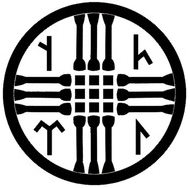
Tengrism, also known as Tengriism, Tenggerism, or Tengrianism, is an ancient and medieval Central Asian–Eurasian Steppe sky god Tengri-centered state religion as well as a number of modern Turko-Mongolic native religious movements and teachings. It was the prevailing religion of the Turks and Mongols, Huns, and, possibly, the Manchus and Magyars, as the religion of the several medieval states: Göktürk Khaganate, Western Turkic Khaganate, Eastern Turkic Khaganate, Old Great Bulgaria, Danube Bulgaria, Volga Bulgaria, and Eastern Tourkia (Khazaria). In Irk Bitig, Tengri is mentioned as Türük Tängrisi. According to many academics, at the imperial level, especially by the 12th–13th centuries, Tengrism was a monotheistic religion; most contemporary Tengrists present it as being monotheistic too.
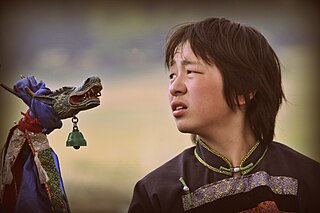
A large minority of people in North Asia, particularly in Siberia, follow the religio-cultural practices of shamanism. Some researchers regard Siberia as the heartland of shamanism.
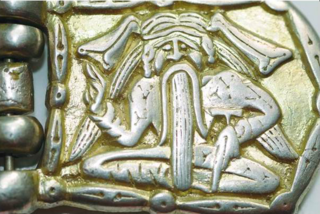
Hungarian shamanism is discovered through comparative methods in ethnology, designed to analyse and search ethnographic data of Hungarian folktales, songs, language, comparative cultures and historical sources.
Dualism in cosmology or Dualism is the moral or spiritual belief that two fundamental concepts exist, which often oppose each other. It is an umbrella term that covers a diversity of views from various religions, including both traditional religions and scriptural religions.
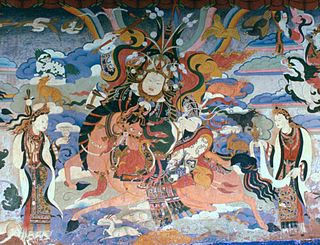
The Mongol mythology is the traditional religion of the Mongols.
Buga is a creator god and omnipotent highest power in the mythology of the Tungusic peoples.
The Tungusic creation myths are traditional stories of the creation of the world belonging to the Tungusic peoples of Siberia.

Mu (무) is an ancient Korean word defining a shaman in the Korean traditional religion. Korean shamans hold rituals called gut for the welfare of the individuals and the society.
Yuri Vella,, full name Yurii Kilevich Aivaseda, known by his pseudonym Yuri Vella, was a writer, poet, environmentalist and social activist of the Forest Nenets people from West-Siberia.
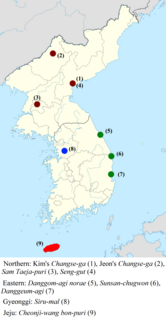
Korean creation narratives are Korean shamanic narratives which recount the mythological beginnings of the universe. They are grouped into two categories: the eight narratives of mainland Korea, which were transcribed by scholars between the 1920s and 1980s, and the Cheonji-wang bon-puri narrative of southern Jeju Island, which exists in multiple versions and continues to be sung in its ritual context today. The mainland narratives themselves are subdivided into four northern and three eastern varieties, along with one from west-central Korea.













